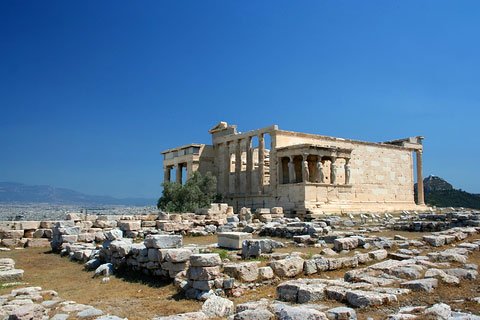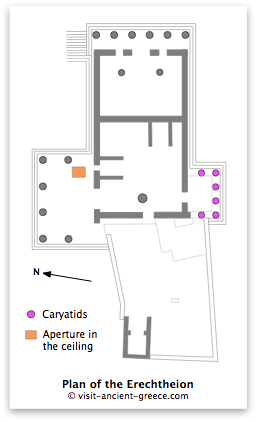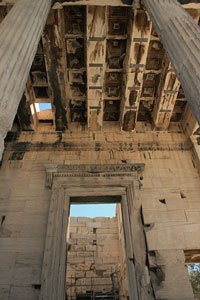The Erechtheion was begun in about 420BC. It was built next to an old temple which it was designed to replace. It is the youngest temple on the Acropolis.
Erechtheus (or Erechthonios) is thought to have been a very ancient king of Athens, who was also thought to have been a god.
One version of the story claims that Erechtheus was defeated by the god Poseidon who slew him with his trident. Another version says Zeus did him in with a thunderbolt. In spite of being killed Erechtheus reached cult status, and managed somehow to have his name attached to this building.

A complex site
There were in fact some very ancient shrines on this part of the Acropolis, and the new building was designed to incorporate these shrines and unite them. This explains why the ground plan is so complex. The builders couldn’t have chosen a more difficult place, as the structure is built on a number of levels.
The different sections
The patron goddess of Athens was Athena Polias, and a wooden cult statue of her resided in the eastern part of the temple. King Erechtheus had his tomb in the west section.
The first king of Athens according to legend was King Cecrops, and his tomb is supposed to be on the south side underneath the caryatid porch. This is the famous little section which you see in millions of photos, where the entablature is supported by six statues of maidens instead of the usual columns. The ones on the Acropolis are copies – you can see the originals in the Museum, although one is still in the British Museum.

Once upon a time…
…Athena and Poseidon both claimed to be the deity of Athens. In order to decide who should have this honour, they held a contest. They were both to display their powers, and Poseidon showed his by striking the Acropolis with his trident. Sea water flowed out, as you’d expect as he was god of the sea.
Then Athena demonstrated her powers, and also struck the ground. But now the result was the first olive tree, and as you may know, olives were very important to the Greeks. So Athena won the contest, and was thereafter revered by the Athenians.

Legends in stone (and tree)
Now you know the legend, go around to the north side and look in between the columns. Now look up above the door and to the left. In the ceiling you’ll notice a space. This is not damaged, as you might imagine. The architects of the Erechtheion deliberately left this space to show the path of Poseidon’s trident when it struck the Acropolis. Through an opening in the floor there are marks in the rock where the ancient Athenians believed the trident left its mark.
A cistern was situated in here as well. Some plaster lining remains, although it is thought to come from later times. Pausanias claims that the cistern contained the salt water from Poseidon – the Erechtheian sea, and it roared when there was a south wind, just like the real sea!
On the west of the Erechtheion you’ll see an olive tree. This one was planted in recent times by Queen Sophia. The original one was destroyed by the Persians when they sacked Athens in the 480 BC. According to the ancient Greeks it sprouted up the very next day…!

Continuing restoration
You can see the parts of the Erechtheion which have been restored, as the marble is new and no attempt is made to try and make it look aged. Don’t forget to visit the New Acropolis Museum, where other remains from the Erechtheion as well as the caryatids can be seen.